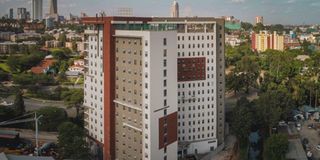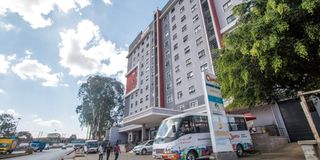Why Kenya needs more purpose-built student accommodation
Sponsored by Acorn Investment Management Ltd

Qwetu Wilson, Nairobi.
Kenyan students are largely forgotten for the college-going period of their lives. The impact of the Covid-19 pandemic has, however, thrust the supporting services that make students' life satisfying, into the limelight.
The vital nature of accommodation is being reconsidered as part of the conversation geared towards returning to normal.
With 75 percent of Kenya’s population under the age of 35 years of age, it only makes sense that their needs be prioritised when discussing matters of national importance such as housing.
A trip to any fledgling area around our universities and colleges will provide sufficient evidence to what Acorn Holdings CEO Edward Kirathe calls a market failure. Kenya’s median age is 18 years of age, and yet the housing market has done very little to address the gap for citizens in the college-going bracket.
A large youth population paired with rapid urbanisation creates a cocktail of acute needs, a primary one being student accommodation that is purpose-built to fit the requirements of the modern-day student.
University enrolment has increased from 27,000 in 1989 to 560,000 in 2016, but without a corresponding increase in investment in student housing. Approximately 40,000 beds are available in on-campus student accommodations against an ever-increasing student population.

Qwetu Parklands, Nairobi
The uncertainty brought by the pandemic poses a major challenge, as higher learning slows down due to the restrictions in place to help mitigate the spread of the virus. Secondary school students are expected to join universities soon and even this is not a new phenomenon. We may witness another public universities' double intake accommodation crisis similar to the one in 2013. Today, little progress has been made in creating more student housing.
The significant strain already placed on on-campus housing has seen students either resort to unsafe overcrowding, illegal subletting, or venture out into nearby neighbourhoods to find accommodations at prices significantly above their capabilities. Those who cannot afford such private housing are forced to live in dilapidated dwellings that not only directly affect their ability to learn, but also impact their overall safety and wellbeing.
Accommodation, however, doesn’t only regard a place for students to lay their heads. Rather, it must focus on providing a conducive environment for young people to explore their new-found freedom safely, and promote learning, growth, and holistic personal development.
A study commissioned by Acorn Holdings found that security, amenities provided, rent charged and location were the top four deciding factors for students when selecting accommodation.
Security is clear to everyone. No one wants to be mugged on their way to class early in the morning, or return home to find their room cleaned out by thugs while they were away.
The amenities modern students require include reliable water and electricity supply, 24-hour high-speed internet access, and exercise and leisure facilities nearby.

Qwetu Ruaraka, Nairobi.
Furthermore, the modern Kenyan is concerned not only about the place they live, but also the impact that it has on their future. As the world turns towards net-zero goals in climate change and net positive targets in social sustainability, the real estate sector is under immense pressure to adapt and become part of the solution. This calls for purpose-built student accommodation that focuses on sustainability for the long term.
Purpose-built student accommodation, therefore, not only must meet the needs of the parent who wants their child to make the transition from a routine, structured by the authority of their parents, to one the child creates for themselves, but also that of a world increasingly cautious about its impact on the planet.
Sustainability during construction and operation calls for efficient use of natural resources such as water, energy and land. Planned densification, where building is done upwards instead of outwards, allows developers to reduce the financial constraints caused by high land costs, while reducing the distance between housing and associated utilities and amenities.

Qwetu Aberdare Heights
Climate-smart developers also have the opportunity to construct housing that leverages natural light and grey water to reduce their overall resource usage. The involvement of third-party sustainability monitoring partners, therefore, is important when thinking about student housing in particular, and urban development in general.
Social, financial and environmental sustainability are not only buzzwords but also play a key role in ensuring thriving communities. Addressing market failures, therefore, in clean, safe and affordable ways, is the basis to creating a thriving business that benefits everyone. Purpose-built student accommodation falls squarely in that market gap and will be central in creating an enabling environment for today’s students to develop into tomorrow’s leaders.
Below are some comparative statistics on the demand gaps.



